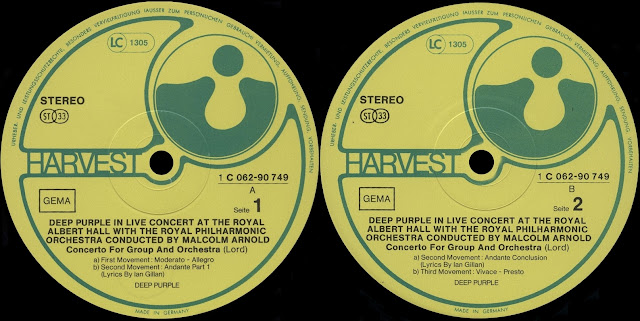DEEP PURPLE. 1970
CONCHERTO FOR GROOP
AND ORCHESTRA. LP (GERMANY)
Harvest – 1C 062-90 749
Matrix / Runout (Side A): 1C062-90749-A-1
Matrix / Runout (Side B): 1C062-90749-B-1
Vinil, LP, Stereo, 33 1/3, Album,
Страна: Germany
Записан / Выпущен: 24 сентября 1969 год. / 1970
Жанр,стиль: Симфо-рок, Прогрессивный рок
mp3 320 кбит/сек. 128 Mb
Продолжительность: 53:35
TRACKLIST :
Seite 1:
01. First Movement: Moderato - Allegro - 19:02
02. Second Movement: Andante Part 1 - 06:30
Seite 2:
03. Second Movement: Andante Conclusion - 12:34
04. Third Movement: Vivace - Presto - 15:28
Музыка и партитура - Jon Lord
Тексты - Ian Gillan
DEEP PURPLE:
Jon Lord: keyboards
Ritchie Blackmore: guitar
Ian Gillan: vocals
Roger Glover: bass
Ian Paice: drums
The Royal Philharmonic Orchestra, conducted by Malcolm Arnold
Студия звукозаписи – Royal Albert Hall
De Lane Lea Recording Studios Mobile Unit
An Edwards-Coletta Production.
Engineers: Dave Siddle & Martin Birch
Cover design: Castle, Chappell & Partners Ltd.
Photography: Daily Express and British Lion Films
FIRST MOVEMENT
Here I have tried to present the Orchestra and Group as you would expect to hear them — as antagonists.
The movement starts with a lengthy orchestral introduction built around the opening clarinet tune, and the following five note semiquaver figure. This merges into a slightly grotesque little tune which starts to get hold of the Orchestra until violently thrown aside by the Group, who then settle down to their own interpretation of the clarinet tune. The Orchestra interrupts, regains control and celebrates its conquest with a hearty tune on the French horns, taken up in turn by various other instruments before being blown out once more by the Group. Another orchestral interruption leads into the guitar cadenza. Material from the introduction reappears and resolves into a short clarinet solo. A change of tempo, and a sparring match Betweeen Group and Orchestra leads to the final chords.
SECOND MOVEMENT
This movement is mainly built around two tunes. The first is played by the cor anglais, the second shortly afterwards, by the flutes. Both tunes are treated in various ways by the Group and the Orchestra. Separately and together. The flute tune is finally transmogrified to a “‘pop/blues” ex- plosion, followed by the organ cadenza. A string quartet section using the cor anglais tune, brings the Orchestra to a quiet conclusion.
THIRD MOVEMENT
Five loud brass chords lead into the basic 6/8 rhythm of most of the movement. A short percussion passage brings in the drums and bass-guitar and then the whole group,
after which the two forces combine in a sort of rhythmic “free for all’. A series of climaxes lead to the drum cadenza. The percussion section of the Orchestra join in and bring back the 6/8 rhythm, which is shortly changed into 2/4. Two ‘false’ climaxes work up to a crescendo in the full Orchestra followed by a string tremolando, over which
the Group builds up to the final two-octave ‘‘whoop” by the eight horns and the last crashing chord.
The realization that an ambition was about to become a reality was for me both incredibly exciting and terrifying. I had long had the idea of writing a Concerto for Group and Orchestra but probably would not have done it at this time had | not the confidence | have in Ritchie, lan, Roger and lan. Many further thanks are due to Anthony Edwards and John Coletta who, among a thousand other things, booked the Albert Hall. Merely to say thank you to Malcolm Arnold for what he did misses the mark by a million miles. But, having no better words, ‘thank you, Malcolm’. And “thank you" to Judith who was very patient .
Finally a few observations on the critical reaction to the Concerto. This was mixed but, happily, quite heavily biased in the direction of favourable. | am sure that critics are generally sincere in what they do. | am sure that critics are a necessary, if slightly archaic, appendage to the music business. What puzzles me, is that an evening which
was intended to be, and in fact (as witnessed by a very large and glorious audience) turned out to be, FUN, should be treated by some of the critics with such long faced seriousness. Still, to those of you who enjoyed it, God bless you, and to those of you who didn’t— God bless you too! It is sti// only a beginning. Jon Lord
"Концерт для группы с оркестром" - альбом, записанный на концерте в лондонском Альберт-холле 24 сентября 1969 года английской рок-группы Deep Purple и Королевского Филармонического Оркестра, выпущенный на виниле в декабре 1969 года компанией Tetragrammaton в США и в январе 1970 года компанией Harvest Records в Соединенном Королевстве. Это первая запись Deep Purple, на которой появились вокалист Иэн Гиллан и басист Роджер Гловер. Американские оригиналы пластинок 1969 года — редкость, поскольку к моменту выхода альбома фирма Tetragrammaton была банкротом. Последующие тиражи альбома в США делала Warner Bros. - новый лейбл Deep Purple в США......
HARVEST
Авторское общество: GEMA
Made and printed in Germany
Оцифровка: Иван_К (rutracker.org)
СПАСИБО!!!





Комментариев нет:
Отправить комментарий